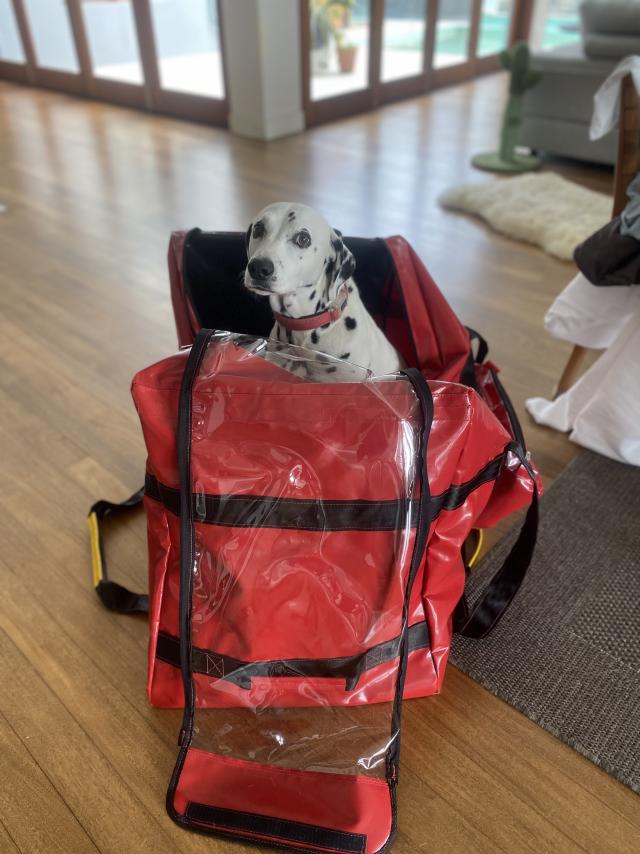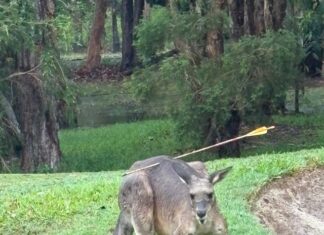LifeFlight Australia’s helicopter crews are well known for saving human lives but now they have the capability to safely rescue beloved, furry family members too.
In an Australian-first, LifeFlight Engineering has created a purpose-built Animal Rescue Capsule (ARC) which can be used to rescue, winch and transport pets securely from life-threatening situations, such as floods.
Group head of operations Yvette Lutze, who helped develop the ARC, said it offers a fit-for purpose option for crews to airlift suitable pets.
“There’s nothing more challenging or upsetting for our crews and for us to have that conversation with someone. They’ve just lost their house, they’ve lost everything, and now you’re asking them to leave their animal behind,“ she said.
“Animals are part of our family, they’re a part of my family.
“What we wanted to do was to provide as many options as we possibly could to ensure that we could keep the pet owners and the pets together, when it is safe to do so.“
The aptly named ARC was invented, after crews rescued a Noah’s ark-worth of pets, as part of the multi-agency emergency response to catastrophic flood events across Queensland and Northern NSW in 2022.
Crews directly assisted more than 100 people, indirectly assisted many more and saved 22 dogs from flooded properties.
In the past and during the disasters from early 2022, equipment bags and Child Rescue Capsules were often used to execute animal winch rescues, but they were not the ideal, permanent solution.
LifeFlight rescue crew officer and flight paramedic Brad Solomon was a member of the LifeFlight team which rescued 19 people and a dog in back-to-back missions on the first day tasked to the Lismore floods.
He said it was a tragedy forever etched in his mind.
“All of us had been involved in previous disasters but the northern NSW floods were certainly a level of disaster we’d never faced before,“ he said.
Adding to the crew’s often-confronting rescues, were encounters with residents who refused to be winched out of danger if it meant leaving their four-legged companions behind.
“It took a bit of negotiation to persuade the residents to be rescued, because their lives were in danger if they didn’t leave the premises at that particular time,“ Mr Solomon said.
“We tried to emphasise ‘we’ll do our best to retrieve your pet’ but our core purpose was to maintain the safety of that person and the aircraft, as well as all of the crew and other survivors onboard.“
The harrowing experience left LifeFlight engineers more determined than ever, to create a new piece of equipment which could guarantee a safe passage for all family members, including pets when appropriate.
While animal winch equipment already existed for Military Working Dogs (MWD), the noises and altitude changes during a chopper mission can be extremely nerve-wracking for stressed, domestic pets.
LifeFlight aircraft safety equipment engineer Simon Jamieson said that meant there were a number of unique safety aspects to consider when creating an animal capsule.
“With the animal rescue bag, one of the benefits that we’ve got there is it is designed specifically for the animals,“ he said.
With operational feedback from the crews, Mr Jamieson was working on refining the first version of the capsule, when LifeFlight choppers were again tasked to floodwater rescues.
Mr Solomon said using the prototype of the capsule in the NSW Central West floods helped crews save more than 13 dogs, two cats and a turtle, along with their owners, from near-death situations.
“The capsule made our rescue missions so much easier and so much safer,“ he said.
Ms Lutze said when it was possible to offer the pet rescue option, distraught flood victims often became much calmer.
“The crews found that when they were able to say ‘just pop your dog in here’, it made the rest of the rescue a lot faster, and also too it de-stressed the people,“ she said.
The now-refined version of the ARC can be re-used for back-to-back rescues, be collapsed to make it compact for winching down to a scene, is reinforced to accommodate pets up to 50 kgs, and has drainage holes to allow water to escape when animals are scooped directly from flood water.
“We engaged with several different experts along the way, including veterinary specialists as well as our own internal team such as equipment designers, aircrew officers, pilots to make sure that we could do this safely,“ Ms Lutze said.
The ARC also features ventilated mesh at the top so the animal inside can look directly up at their rescuer to minimize stress and anxiety.
“You don’t want the animal to stress during the winch, so we wanted to create something more specialised to domestic pet rescues,“ Mr Jamieson said.
Mr Jamison said it was humbling to see something that started as just an idea, turned into lifesaving equipment.
“You see the photos, you see the look on someone’s face, looking down at an animal with just this immense pleasure,“ he said.
“They’ve lost everything else but their entire family is with them.
“It was a fantastic to think that was something I was able to contribute to directly.“







